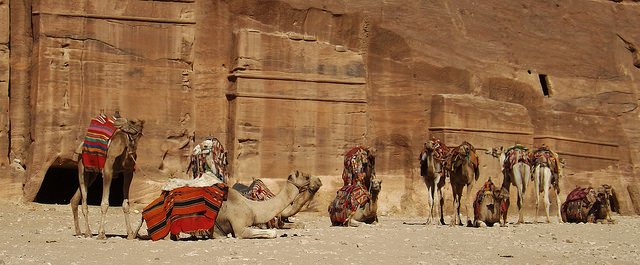Weather in Jordan
 With an arid desert climate, the fascinating country of Jordan is generally hot and dry, except during the short winter season between November and February when temperatures drop appreciably and wet weather, even snow, is possible, particularly in the east.
With an arid desert climate, the fascinating country of Jordan is generally hot and dry, except during the short winter season between November and February when temperatures drop appreciably and wet weather, even snow, is possible, particularly in the east.
Jordan is almost completely landlocked, except for a short strip of Red Sea coast in the extreme south, with a varied topography consisting of plateaux, mountains and the deep Rift Valley in the west. The differing elevations have a localized effect on the climate of Jordan, causing extremes in temperature from an overall average of between 5°C (41°F) to 10°C (50°F) in the coolest month of January to between 20°C (68°F) and 35°C (95°F) in the mid-summer month of August.
In summer the heat is often exacerbated by the scorching, dry southerly wind known as the “Shirocco”, which can be strong enough to cause sandstorms.
Although summer in Jordan is unbearably hot by day, at night temperatures fall to a more comfortable average in the low 20°s C (around 68°F). The extremely low humidity levels in this arid country allow locals and visitors alike to take advantage of the cooler nights.
In general the summer months (June to August) are almost completely dry, with most of the precipitation in Jordan occurring in winter between November and March, sometimes coming as violent storms which can cause local flooding, especially in the north west.
Temperatures in winter in Jordan vary from a maximum of around 13°C (55.5°F) in Amman in January, to around 20°C (68°F) in Aqaba on the Red Sea coastal strip. Aqaba is thus a popular winter holiday destination for Europeans.
As temperatures decrease during winter in Jordan, so the chance of rain increases, although precipitation levels remain low in general, averaging 111mm (4.3 ins) across the country, most falling in the west. In the capital, Amman, which lies in the hills alongside the Rift Valley, and even at the popular tourist attraction of Petra, snow is possible. Below freezing temperatures at night can cause frosts in mid-winter (January), particularly in the north-western highlands.
When is the best time to go to Jordan?
The best time to book a sightseeing holiday in Jordan is during the transitional seasons of spring (between March and May) and autumn (September to November), which allows visitors to avoid the extreme dry heat of the summer months and the chill of the brief winter. For a seaside holiday in Jordan, the popular city of Aqaba in the southern extremity of the country offers fun in the sun and great Red Sea diving opportunities all year round, its coastal location tempering the heat of summer and cold of the winter.
What to pack for a holiday in Jordan
As a Muslim country, Modesty is the dress code here, but some places and events are more liberal. While casual wear is acceptable, the local style prefers trousers to shorts, and collared shirts (short sleeved is fine) to T-shirts. It's best to wear loose fitting, long clothing made from lightweight fabrics, as this will help in the heat. Long sleeved shirts and trousers are particularly useful as sun protection, but T-shirts are more common among tourists and (at least) knee length shorts are acceptable.
Wear lots of sunscreen, bring hats and sunglasses, and wear comfortable sandals or walking shoes for an easy trip. Entering any holy place requires almost complete covering, for both men and women. Note that the dress code is more liberal at resorts and beaches, but even then, wear a one-piece swimsuit, and always have a sarong or light covering. There are nightclubs in the country and when inside the style is typically Western; but remember to cover-up when travelling to and from the nightclub.
Related Content:
- Login to post comments

